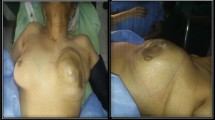Abstract
Lipid-secreting carcinoma is a rare variant of breast carcinoma. The tumor cells possess abundant vacuolated cytoplasm containing neutral fat. A 68-year-old Japanese female patient presented with a left breast tumor, which was detected by mass screening, and she was admitted to our hospital. The physical examination revealed an elastic hard lump in the left lateral quadrant of the left breast. The tumor size was 1.2 × 1.0 cm in diameter and the borderline was unclear. There were no palpable axillary lymph nodes or supraclavicular nodes. Mammography showed a polygonal mass with microcalcification. Ultrasonography indicated a hypoechoic lesion measuring 9 × 4 mm in diameter, with an irregularly shaped, slightly indistinct surface. The internal echoic level of the mass was heterogenous. Enhanced magnetic resonance imaging revealed a mass of high intensity in the left breast, and the connection of the intraductal spread was not detected. The time–intensity curve showed a peak-and-plateau pattern. Fine-needle aspiration cytology suggested a malignant tumor. The patient underwent a partial resection of the left breast (breast-conserving therapy) and a left axillary lymphadenectomy. Macroscopically, the resected specimen revealed a white tumor measuring approximately 0.6 × 0.5 cm. Histopathologically, the tumor measured up to approximately 0.9 × 0.7 cm because of additional components of intraductal spread and therefore was diagnosed as an extensive ductal carcinoma in situ with focal mass formation; the tumor also had abundant foamy cytoplasm. Oil-red-O staining confirmed the presence of marked cytoplasmic lipid droplets. These droplets were periodic acid–Schiff (PAS) negative even after diastase digestion, and negative with PAS–Alcian blue staining. In immunohistochemistry, these carcinoma cells were positive for E-cadherin. Thus, the pathological diagnosis was a non-invasive form of lipid-secreting carcinoma. The tumors were negative for both estrogen receptors and progesterone receptors. There were no metastases in the left axillary lymph nodes. The patient has remained well for 8 years without any evidence of recurrence.




Similar content being viewed by others
Abbreviations
- MMG:
-
Mammography
- US:
-
Ultrasonography
- MRI:
-
Magnetic resonance imaging
- ER:
-
Estrogen receptors
- PgR:
-
Progesterone receptors
- Her2:
-
Human epidermal growth factor receptor type 2
- DCIS:
-
Ductal carcinoma in situ
References
Aboumrad MH, Horn RC, Fine G. Lipid-secreting mammary carcinoma. Report of a case associated with Paget’s disease of the nipple. Cancer. 1963;16:521–5.
Ramos CV, Taylor HB. Lipid-rich carcinoma of the breast. A clinicopathologic analysis of 13 examples. Cancer. 1974;33:812–9.
Umekita Y, Yoshida A, Sagara Y, Yoshida H. Lipid-secreting carcinoma of the breast: a case report and review of the literature. Breast Cancer. 1998;5:171–3.
World Health Organization. IARC WHO classification of tumours: pathology and genetics of tumours of the breast and female genital organs. In: Tavassoli FA, Devilee P, editors. Lyon: IARC Press; 2003. p. 187.
Goldstein NS, Bassi D, Watts JC, Layfield LJ, Yaziji H, Gown AM. E-cadherin reactivity of 95 noninvasive ductal and lobular lesions of the breast. Implications for the interpretation of problematic lesions. Am J Clin Pathol. 2001;115:534–42.
Shi P, Wang M, Zhang Q, Sun J. Lipid-rich carcinoma of the breast. A clinicopathological study of 49 cases. Tumori. 2008;94:342–6.
Catalina-Fernández I, Sáenz-Santamaria J. Lipid-rich carcinoma of breast: a case report with fine needle aspiration cytology. Diagn Cytopathol. 2009;37:935–6.
Fisher ER, Gregorio R, Kim WS, Redmond C. Lipid in invasive cancer of the breast. Am J Clin Pathol. 1977;68:558–61.
Vera-Sempere F, Llombart-Bosch A. Lipid-rich versus lipid-secreting carcinoma of the mammary gland. Pathol Res Pract. 1985;180:553–8.
Leal C, Henrique R, Monteiro P, Lopes C, Bento MJ, De Sousa CP, et al. Apocrine ductal carcinoma in situ of the breast: histologic classification and expression of biologic markers. Hum Pathol. 2001;32:487–93.
Hayes MM, Seidman JD, Ashton MA. Glycogen-rich clear cell carcinoma of the breast. A clinicopathologic study of 21 cases. Am J Surg Pathol. 1995;19:904–11.
Mazzella FM, Sieber SC, Braza F. Ductal carcinoma of male breast with prominent lipid-rich component. Pathology. 1995;27:280–3.
Okazaki K, Sasa M, Morimoto T, et al. A case of lipid-rich carcinoma of the breast; which reference to the reported cases in Japan. Jpn J Breast Cancer. 1994;9:169–74.
Author information
Authors and Affiliations
Corresponding author
About this article
Cite this article
Nagata, Y., Hanagiri, T., Ono, K. et al. A non-invasive form of lipid-secreting carcinoma of the breast. Breast Cancer 19, 83–87 (2012). https://doi.org/10.1007/s12282-010-0237-2
Received:
Accepted:
Published:
Issue Date:
DOI: https://doi.org/10.1007/s12282-010-0237-2




